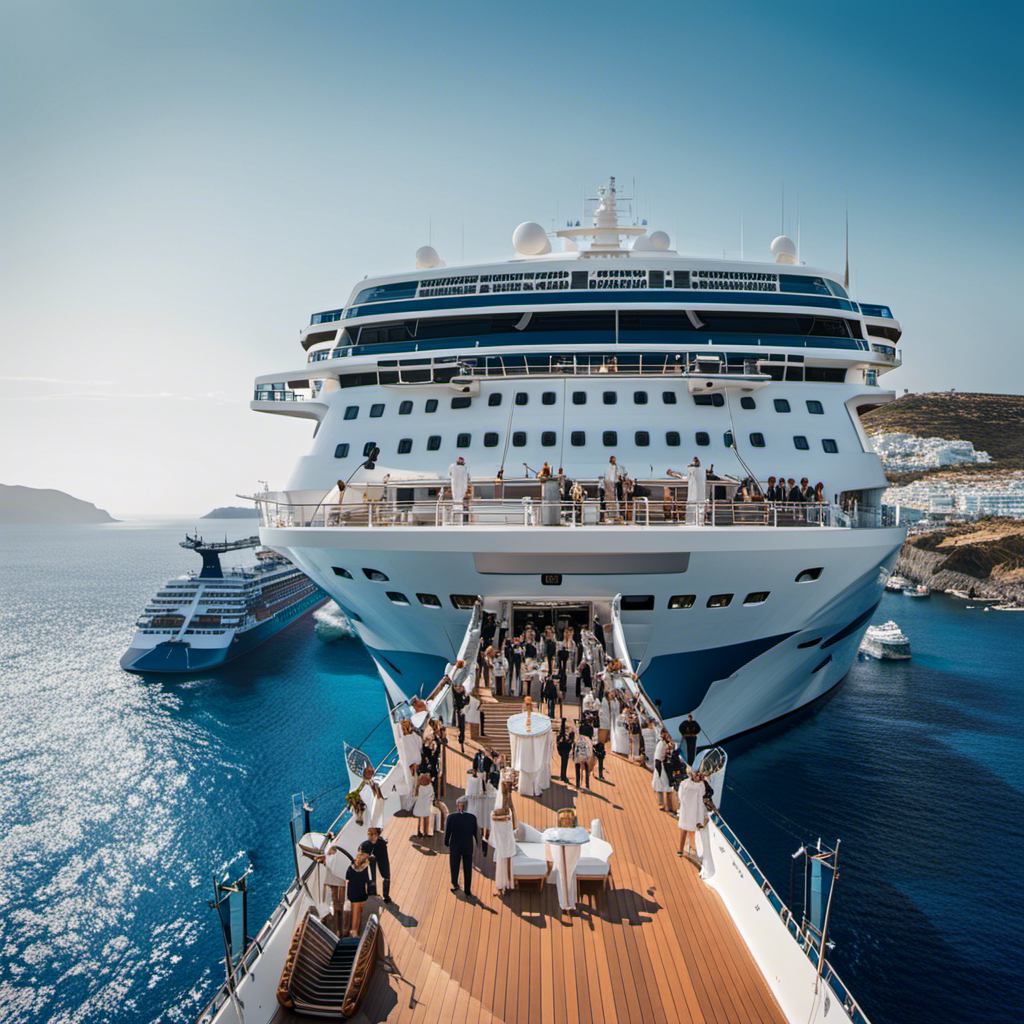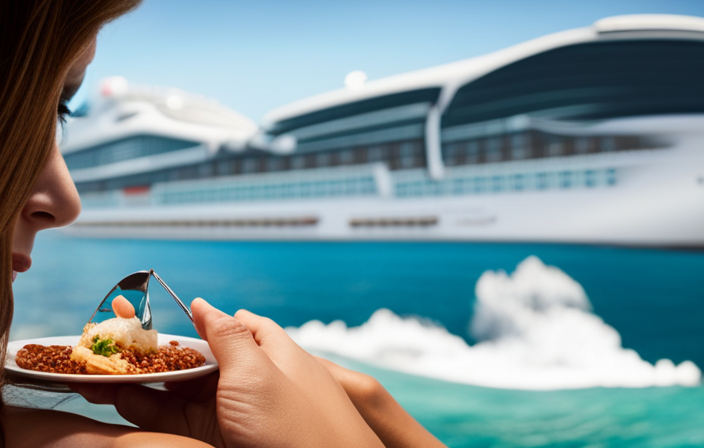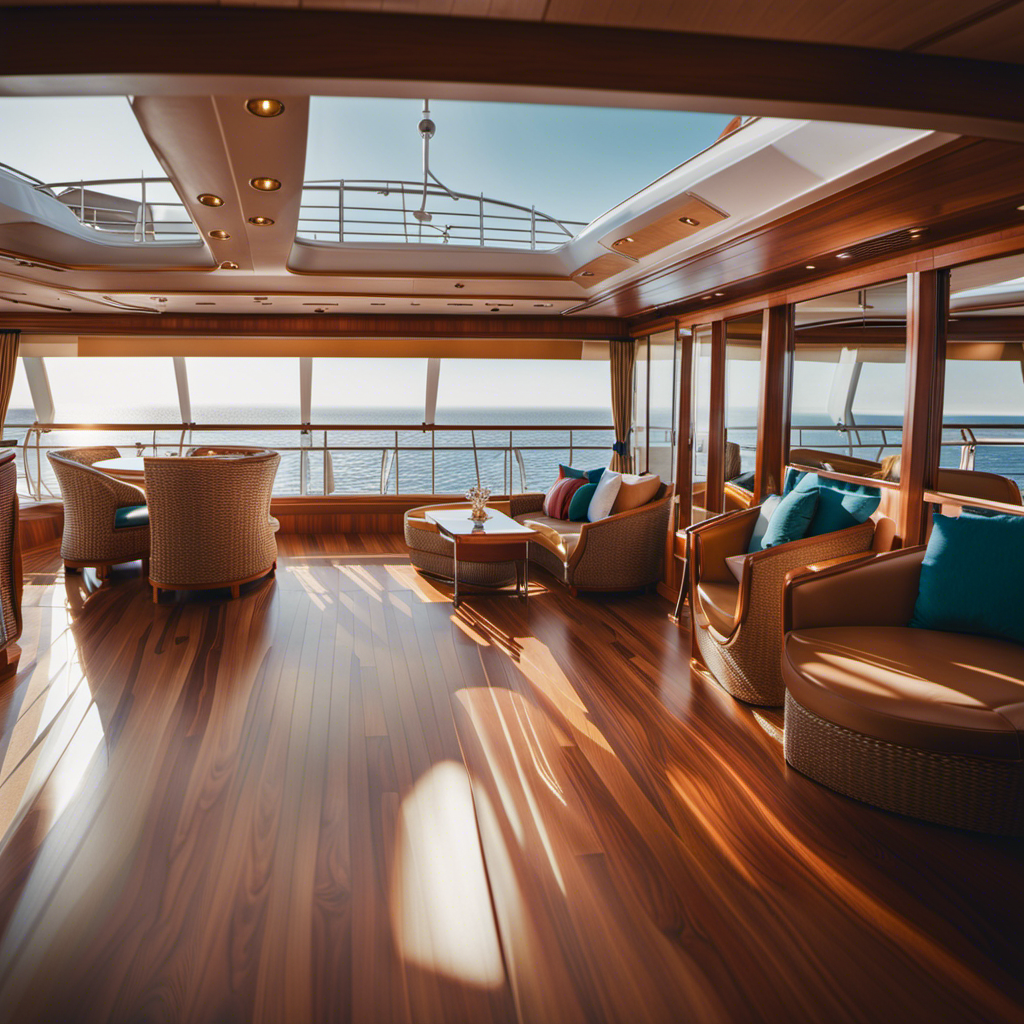It is important to understand how cruise ship toilets work because a typical cruise ship can generate over 200,000 gallons of wastewater each day.
As a frequent traveler on these magnificent vessels, I’ve always been fascinated by the intricate plumbing systems that make our onboard experiences comfortable and hygienic.
In this article, we will delve into the technical details of cruise ship toilets, exploring the process of flushing and waste removal, the role of vacuum systems, and the complex network of pipes and plumbing systems that ensure everything runs smoothly.
We will also examine the methods of waste treatment and disposal used on cruise ships, as well as the maintenance and cleaning procedures necessary to keep these facilities in top condition.
Join me on this journey as we uncover the inner workings of cruise ship toilets and gain a newfound appreciation for the engineering marvels that make our time at sea so enjoyable.
Key Takeaways
- Cruise ship toilets utilize smart toilet technology for efficient and environmentally-friendly bathroom experiences.
- Innovations in water conservation have revolutionized toilet operations on cruise ships, reducing water consumption without compromising cleanliness.
- Advanced waste management systems, including vacuum toilets and waste treatment systems, ensure comfort, hygiene, and minimal environmental impact for passengers.
- Technological advancements have revolutionized the bathroom experience on cruise ships, focusing on passenger comfort and providing a truly exceptional toilet experience for all onboard.
Understanding the Basics of Cruise Ship Plumbing
Cruise ship toilets operate using a complex plumbing system that efficiently manages waste disposal and water usage. These waste management systems are designed to ensure the proper disposal of human waste in a sanitary and environmentally friendly manner.
To achieve this, cruise ships employ a variety of technologies, including vacuum toilets and macerators. Vacuum toilets use suction to remove waste from the toilet bowl and transport it to a central vacuum collection tank. Macerators, on the other hand, shred solid waste into smaller particles before it is flushed away.
Additionally, cruise ships implement water conservation measures to minimize water usage. These measures include low-flow toilets, which use less water per flush, and water recycling systems, which treat and reuse wastewater.
Understanding the basics of cruise ship plumbing is essential for comprehending the process of flushing and waste removal that follows.
The Process of Flushing and Waste Removal
Ironically, the flushing process on board a luxury liner involves a rather intricate system of waste removal. Cruise ship toilets are specially designed to efficiently flush waste while conserving water. These toilets are equipped with a powerful vacuum system that creates a strong suction to remove waste from the bowl.
When the flush button is pressed, a valve opens, allowing water to rush into the bowl and create a vortex. Simultaneously, the vacuum system activates and pulls the waste through a network of pipes. This vacuum system not only ensures efficient waste removal but also helps in conserving water by using less water per flush compared to traditional toilets.
The waste is then transported to a storage tank where it is stored until it can be properly disposed of at designated ports.
Transitioning into the next section, the role of vacuum systems in cruise ship toilets is crucial for maintaining the hygiene and functionality of these systems.
The Role of Vacuum Systems in Cruise Ship Toilets
Take a moment to imagine yourself on a luxury liner, where an essential component, the vacuum system, plays a crucial role in maintaining the cleanliness and functionality of the waste removal process. The vacuum system, unlike traditional gravity-based systems, uses suction to transport waste through a network of pipes. This system consists of three main components: a vacuum pump, a collection vessel, and a network of smaller pipes. As waste is flushed down the toilet, the vacuum pump creates negative pressure, sucking the waste into the collection vessel. The waste is then stored until it can be properly disposed of at port. While vacuum systems offer many advantages, such as reduced water usage and increased flexibility in ship design, they also have some disadvantages. These include the need for regular maintenance and the potential for blockages. As a result, alternative toilet technologies, such as macerating toilets, are being explored. These toilets use a grinder to break down waste before it is flushed, reducing the risk of blockages. Moving on to the subsequent section about the intricate network of pipes and plumbing systems, it is important to understand the overall process of waste transportation on a cruise ship.
The Intricate Network of Pipes and Plumbing Systems
Step into the world of luxury liners and picture the intricate network of pipes and plumbing systems that seamlessly transport waste on board. To understand the sewage treatment process and the importance of proper waste management on cruise ships, it’s essential to delve into the complex plumbing system that supports these operations.
Here’s a visual representation of the system:
-
Collection: Waste is collected from toilets and other onboard facilities.
-
Macerators: Solid waste is shredded into smaller particles for easier transport.
-
Vacuum toilets: Vacuum pressure is used to transport waste through a network of pipes.
-
Greywater treatment: Greywater, which includes wastewater from sinks and showers, is treated separately.
-
Effluent treatment: The waste is treated through a combination of physical, chemical, and biological processes.
This intricate system ensures efficient waste management on cruise ships, minimizing environmental impact.
Moving forward, let’s explore the waste treatment and disposal processes on these luxury liners.
Waste Treatment and Disposal on Cruise Ships
Witness the fascinating waste treatment and disposal methods employed on luxury liners as you discover the intricate processes that ensure a cleaner, greener environment onboard. Waste treatment on cruise ships is a complex and carefully managed system designed to minimize environmental impact and support sustainability efforts.
The first step in waste treatment is the separation of solid and liquid waste. Solid waste, such as toilet paper and food scraps, is collected and incinerated at high temperatures to reduce volume and eliminate odors. Liquid waste, including sewage and greywater, undergoes a series of treatment processes. This includes filtration, disinfection, and chemical treatment to remove harmful substances and pathogens. Once treated, the water is either discharged into the ocean, in compliance with strict regulations, or reused for non-potable purposes onboard.
Witnessing these waste treatment methods highlights the cruise industry’s commitment to environmental impact and sustainability efforts. Transitioning into the subsequent section, let’s explore the various initiatives undertaken by cruise lines to further enhance their environmental practices.
Environmental Impact and Sustainability Efforts
After learning about waste treatment and disposal on cruise ships, it’s important to consider the environmental impact and sustainability efforts of these massive vessels. Cruise ships have come under scrutiny for their contribution to pollution and the degradation of marine ecosystems. To address these concerns, the industry has been working to comply with environmental regulations and implement alternative waste management systems.
Here are three key ways cruise ships are striving to reduce their environmental impact:
-
Advanced wastewater treatment systems: Cruise ships are implementing onboard systems that treat and purify wastewater before it is discharged into the ocean, ensuring it meets or exceeds regulatory standards.
-
Waste reduction and recycling programs: Cruise lines are actively promoting waste reduction and recycling initiatives onboard, encouraging passengers and crew members to participate.
-
Alternative energy sources: Some cruise ships are exploring the use of alternative energy sources like solar and wind power to reduce their reliance on fossil fuels.
As we delve into the next section about the maintenance and cleaning of cruise ship toilets, it’s important to understand the efforts being made to minimize their environmental footprint.
Maintenance and Cleaning of Cruise Ship Toilets
To truly understand the efficiency and cleanliness of cruise ship toilets, you’ll be amazed to discover the secrets behind their maintenance and cleaning processes.
The maintenance techniques used for cruise ship toilets are highly specialized and designed to keep them in optimal working condition. Regular inspections are conducted to identify any potential issues, such as leaks or clogs, which are promptly addressed.
Cleaning products specifically formulated for marine environments are utilized to ensure thorough sanitation and to prevent corrosion. These products are effective in removing waste and minimizing odors. Additionally, the toilets are regularly disinfected to maintain high hygiene standards.
Transitioning into the next section on common issues and troubleshooting tips, it is important to note that despite these meticulous maintenance efforts, occasional problems may arise that require further attention.
Common Issues and Troubleshooting Tips
Get ready to tackle common issues and troubleshoot like a pro when it comes to maintaining the efficiency and cleanliness of your cruise ship toilet! To ensure smooth operation, it’s important to be prepared for any troubleshooting solutions that may arise.
One common malfunction is a clogged toilet, which can be caused by excessive toilet paper or foreign objects. To fix this, use a plunger or a toilet auger to remove the blockage.
Another issue is a leaky toilet, which may be caused by a faulty seal or a cracked pipe. In this case, replacing the seal or repairing the pipe can solve the problem.
Additionally, a constantly running toilet can be fixed by adjusting the float valve or replacing the fill valve.
By addressing these common malfunctions promptly, you can ensure the smooth operation of your cruise ship toilet.
Now, let’s explore the innovations in cruise ship toilet technology.
Innovations in Cruise Ship Toilet Technology
Now that we’ve discussed common issues and troubleshooting tips for cruise ship toilets, let’s dive into the exciting world of innovations in cruise ship toilet technology.
With the advent of smart toilet technology, cruise ships are constantly striving to provide a more efficient and environmentally-friendly bathroom experience for their passengers. These advancements in water conservation have revolutionized the way toilets operate on board.
Smart toilets now utilize cutting-edge sensors and high-tech controls to regulate water usage, ensuring minimal waste and maximum efficiency. These toilets are designed to detect the user’s presence and adjust the water flow accordingly, reducing water consumption without compromising on cleanliness.
By incorporating these advancements, cruise ship companies are not only improving the overall experience for passengers but also contributing to a more sustainable future. By ensuring a comfortable and hygienic experience for passengers, cruise ships are able to create an atmosphere of relaxation and luxury.
Ensuring a Comfortable and Hygienic Experience for Passengers
Passengers can now indulge in a truly luxurious and refreshing bathroom experience on cruise ships, thanks to the innovative technology that ensures their comfort and hygiene. The cruise ship industry has made significant advancements in passenger satisfaction by implementing state-of-the-art waste management systems.
These systems are designed to efficiently and effectively handle the waste generated onboard, ensuring a clean and pleasant environment for passengers. One key aspect of these innovations is the use of vacuum toilets. Unlike traditional flush toilets, vacuum toilets use air pressure to remove waste from the bowl. This not only reduces water consumption but also eliminates the unpleasant odors associated with traditional toilets.
Additionally, cruise ships now utilize advanced waste treatment systems that process and treat the waste before it is discharged into the ocean. This ensures that the impact on the environment is minimized, further enhancing passenger satisfaction.
Overall, these technological advancements in cruise ship toilet systems have revolutionized the bathroom experience for passengers. With improved waste management and a focus on passenger comfort and hygiene, cruise ship toilets now provide a truly exceptional experience for all onboard.
Frequently Asked Questions
Are cruise ship toilets connected to the same plumbing system as the sinks and showers?
Yes, cruise ship toilets are connected to the same plumbing system as the sinks and showers. This ensures efficient waste disposal and reduces the risk of clogging. It’s crucial for the smooth operation of the ship.
How often are cruise ship toilets cleaned and maintained?
Cruise ship toilets undergo regular cleaning and maintenance procedures. Cleaning frequency depends on ship policies, but it is typically done daily or multiple times a day. Maintenance includes inspections, repairs, and replacement of parts to ensure proper functionality and hygiene.
Is there a limit to how much toilet paper can be flushed on a cruise ship?
Yes, there is a limit to how much toilet paper can be flushed on a cruise ship. This is to ensure proper toilet paper waste disposal and minimize the environmental impact of cruise ship toilets.
What happens to the waste once it is removed from the toilets?
What happens to the waste once it is removed from the toilets? How is the waste disposal process on cruise ships? The waste is collected in storage tanks and treated before being discharged, ensuring minimal environmental impact.
Are there any specific regulations or guidelines for cruise ship toilets to ensure passenger safety and hygiene?
There are specific regulations and guidelines for cruise ship toilets to ensure passenger safety and hygiene. These focus on compliance with sanitation standards, waste management protocols, and providing a comfortable experience for passengers.
Conclusion
In conclusion, cruise ship toilets are a marvel of engineering, designed to ensure a comfortable and hygienic experience for passengers.
While some may argue that the intricate network of pipes and plumbing systems can be overwhelming, it’s important to remember that regular maintenance and cleaning are carried out to address any issues that may arise.
Additionally, innovations in cruise ship toilet technology continue to improve efficiency and waste treatment. So, rest assured that cruise ship toilets are meticulously designed to provide a seamless and hassle-free experience for all on board.
Alfons is the visionary leader and driving force behind Voyager Info’s success. As the Editor in Chief, he brings a wealth of experience and an unwavering passion for travel to the helm of our cruise-centric platform.
With a lifelong fascination for exploring new horizons, Alfons discovered his love for the ocean and cruising at a young age. From sailing across pristine Caribbean waters to embarking on daring expeditions to far-flung destinations, he has amassed a treasure trove of first-hand experiences in the world of cruising.











